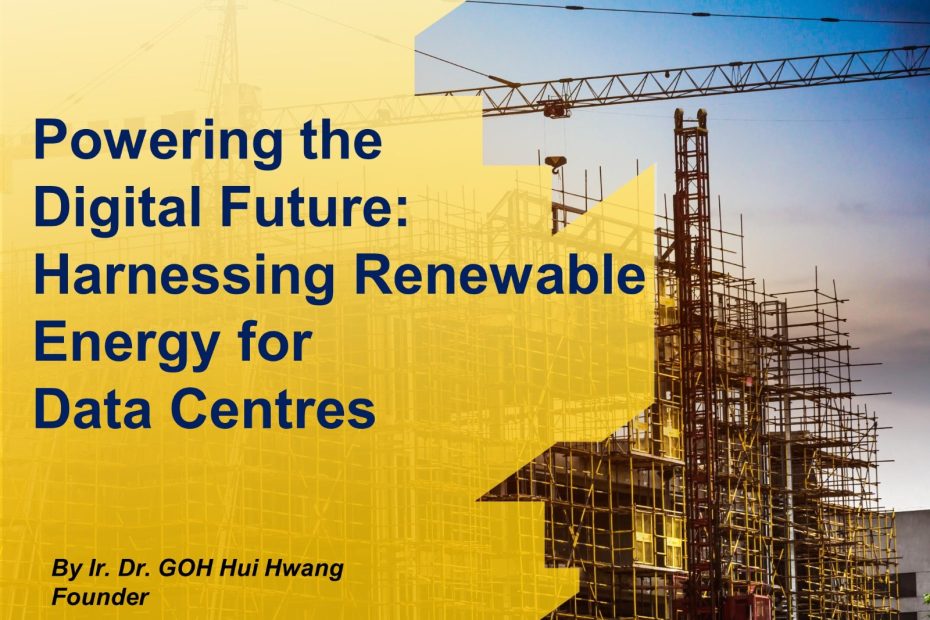Author: Ir. Dr. GOH Hui Hwang | 28 July, 2024
Introduction
Data centres have become the crucial infrastructure for global communication and data storage in the age of digital transformation. Nevertheless, these remarkable technical advancements also have a substantial electricity demand, representing approximately 1 to 1.3% of the global electricity usage [1]. In light of the global shift towards sustainable growth and the imperative to achieve the objectives outlined in the Paris Agreement, it is essential to promptly convert data centres to renewable energy sources. Recently, there has been a substantial amount of research focused on tackling this issue by suggesting a holistic approach that integrates cutting-edge methods for supplying data centres with renewable and environmentally friendly energy sources.
Significance of renewable energy in data centres
Renewable energy is crucial for mitigating the carbon emissions associated with data centres due to its minimal ecological footprint and infinite sustainability. Data centres can utilise solar, wind, hydro, and biomass energy sources to meet their significant power needs [1]. Research highlights the imperative of combining renewable energy systems with smart grid technology to improve energy utilisation and distribution, resulting in more reliable and efficient data centre operations.
Google’s investment in Malaysia, amounting to RM9.4 billion, is intended to construct a data centre and cloud region. This action underlines the increasing demand for data services in the area [2]. This investment additionally offers the chance to include sustainable energy solutions into the infrastructure of the data centre. Google can effectively lower its operational expenses and support Malaysia’s sustainability objectives by utilising local renewable resources.
The incorporation of renewable energy systems necessitates the utilisation of diverse approaches to precisely predict the erratic behaviour of renewable energy. This can be accomplished by utilising weather data and historical knowledge. This methodology can assist in determining the energy composition for data centres, ensuring a harmonious balance between availability and demand [1]. Integrating energy storage technology, such as batteries or pumped hydro storage, can enhance the dependability of power supply derived from renewable sources.
Circular economy-based energy autonomy data centres
The circular economy (CE) is a break from the traditional linear economy. It replaces the linear model of resource use with a closed-loop circular model that adheres to the “3R” principles: Reduce, Reuse, and Recycle. The data centre is constructed based on the principles of the circular economy and has a smart and sustainable closed-loop energy cycle [3]. Utilising sustainable energy sources such as solar, wind power, biomass, and geothermal aids in reducing energy use. Reutilization refers to the process of producing and using electricity, gas, heat, and other types of energy derived from renewable sources. Any excess energy is transformed and reused.
Recycling is the process of preserving and converting excess power, gas, heat, and other types of energy into resources that can be used in the future. Research suggests that this energy cycle has a substantial beneficial effect on the proportion of renewable energy and energy efficiency [3]. The data centre effectively repurposes and harnesses the significant waste heat produced by its high energy consumption, leading to an ideal operational setting [4]. The data centre, constructed based on the principles of the circular economy, embodies a novel paradigm for upcoming digital transformation and sustainable expansion.
Challenges and solutions
The adoption of renewable energy sources is not without obstacles. Renewable energy infrastructure presents concerns regarding intermittency, which refers to the unpredictable nature of renewable energy sources, grid stability, which pertains to the power grid’s ability to handle fluctuations in renewable energy supply, and the significant upfront investment required to establish renewable energy infrastructure. Nevertheless, research provides techniques to surmount these obstacles. Advanced forecasting models are effective in managing the unpredictable characteristics of renewable energy sources [1].
Furthermore, the adoption of demand-side management systems can enhance the efficacy of energy consumption patterns. Policy and regulatory frameworks are essential for governments and regulatory authorities to facilitate the integration of renewable energy sources into data centres. Offering incentives, such as tax exemptions and subsidies, can effectively motivate data centre operators to participate in renewable energy initiatives. Furthermore, the implementation of a supportive policy framework can accelerate the expansion of renewable energy in the data centre business by establishing a favourable environment.
Conclusion
The viability of data centres in the future hinges on their capacity to conform to a sustainable energy strategy. Research provides a clearly defined approach for incorporating renewable energy into data centre operations, providing significant insights for establishing a more environmentally aware and sustainable digital future. Given the increasing influence of large multinational corporations such as Google in their data centre infrastructure, it is crucial for enterprises to prioritise the use of renewable energy as their main source of electricity. This method not only supports environmental objectives but also showcases the long-term economic viability, guaranteeing the sustainability and durability of data centre operations in light of increasing energy requirements.
Ir. Dr. GOH Hui Hwang
Founder
IPM Group
References:
[1] Goh, H.H., et al. (2022). A multimodal approach to chaotic renewable energy prediction using meteorological and historical information. Applied Soft Computing, 118, 108487.
[2] Google to invest RM9.4b in Malaysia to set up data centre and cloud region. (n.d.). Retrieved on 28 July 2024 from https://www.malaymail.com/news/malaysia/2024/05/30/google-to-invest-rm94b-in-malaysia-to-set-up-data-centre-and-cloud-region/137176
[3] Xie H, Goh H.H, et al. (2024). Community-based virtual power plants’ technology and circular economy models in the energy sector: A Techno-economy study. Renewable and Sustainable Energy Reviews, 192, 114189.
[4] Liang X, Goh H.H, et al. (2022). Utilizing landfill gas (LFG) to electrify digital data centers in China for accelerating energy transition in Industry 4.0 era. Journal of Cleaner Production, 369, 133297.

